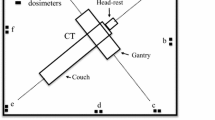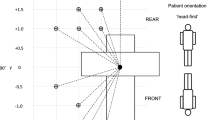Abstract
Advancements in and increasing usage of complex diagnostic examinations with interventional procedures and surgeries has led to an increase in the occupational radiation doses received by physicians and other medical staff. Measuring the scattered radiation doses received by these staff is vital for the development-effective radiation protection programs. In this study, we measured scattered doses during angiography and digital breast tomosynthesis examinations with small-type dosimeters using our jungle gym (JG) method with measurement points at 50-cm intervals. The results were compared with measurements taken using the conventional ion chamber method. The JG method uses paper pipe tubes and a plastic joint structure and allows measurements at different points inside an examination room. The difference between measurements can be attributed to the radiation absorption characteristics of the components used in the JG method. A maximum radiation dose reduction of 20% was observed due to absorption by the JG components. This effect was smaller than the measurement error produced because of reproducibility issues and other limitations of the conventional method. The conventional measurement has disadvantages that are associated with the reproducibility of measurement points, equipment load, and the radiation exposure experienced by the measurer. The proposed JG method exhibits significant improvements in all these aspects. Furthermore, the measurer does not have to be present in the measurement room; therefore, the JG method is extremely safe and useful for radiation protection.







Similar content being viewed by others
References
ICRP 85. Avoidance of radiation injuries from medical interventional procedures. International Commission on Radiological Protection (ICRP) Publication 85. Ann ICRP. 2000;30(2):64.
ICRP 139. Occupational radiological protection in interventional procedures. International Commission on Radiological Protection Publication 139. Ann ICRP. 2018;47(2):72–83.
Willams JR. The interdependence of staff and patient doses in interventional radiology. BJR. 1997;70:498–503.
Balter S. Stray radiation in the cardiac catheterisation laboratory. Radiat Prot Dosimetry. 2001;94:183–8.
Iida H, et al. The measurement of scatter radiation distributions in X-ray rooms. J Radiat Prot Sec Jpn Soc Radiat Technol. 2004;18:48.
Nakamura T, Suzuki S, Takei Y, Kobayashi I, Pongnapang N, Kato K. Simultaneous measurement of patient dose and distribution of indoor scatter radiation during digital breast tomosynthesis. Radiography. 2019;25(1):72–6.
Ito H, Kobayashi I, Watanabe K, Ochi S, Yanagawa N. Evaluation of radiation from fluoroscopy using small OSL dosimeters. Radiol Phys Technol. 2019. https://doi.org/10.1007/s12194-019-00536-4.
“Simulation Monte Carlo Simulation of Side Scattering of Diagnostic X-rays” (https://hidekikato1952.wixsite.com/radiotechnology/free-software), using the software created by Hideki Kato (X-Scatter-2 for Windows)
Fetterly KA, Schueler BA, Grams MP, Sturchio GM. Estimating head and neck tissue dose from x-ray scatter to physicians performing X-ray guided cardiovascular procedures: a phantom study. J Radiol Prot. 2017;37(16):43–58.
Sato H, Mori K, Fujisaku K, Yoneda H. Development of EGS5 Monte Carlo toolkit for estimation of dose distribution in X-ray diagnostic room. Jpn J Med Phys. 2010;30:25–38.
Shimada M. Application of Monte Carlo simulations (4) area of general radiography. Nihon Houshasen Gijyutsu Gakkai Zasshi. 2015;71(3):271–6.
Tomita H, Morozumi K. Measurement of the distribution of scatter radiation in CT rooms with MDCT equipment using OSL dosimeters. Nihon Houshasen Gijyutsu Gakkai Zasshi. 2004;60(11):1550–4.
Kuribayashi S, Onobori K, Hayashida A, et al. Report on airborne dosimetry during IVR (PTCA). Nihon Houshasen Gijyutsu Gakkai Zasshi. 2001;57(1):33–48.
Hironobu T, Kunihiro M. Measurement of scatter radiation on MDCT equipment using an OSL dosimeter. Nihon Houshasen Gijyutsu Gakkai Zasshi. 2004;60(11):1550–4.
Kusama T, Ono K. Radiology protection manual. 3rd ed. Tokyo: Japan Medical Association; 2013. p. 75–77.
Reynolds TA, Higgins P. Surface dose measurements with commonly used detectors: a consistent thickness correction method. J Appl Clin Med Phys. 2015;16:5572.
Asahara T, Hayashi H, Goto S, Tomita E, Kimoto N, Mihara Y, Asakawa T, Kanazawa Y, Katsumata A, Higashino K, Yamashita K, Okazaki T, Hashizume T. Exposure dose measurement during diagnostic pediatric X-ray examination using an optically stimulated luminescence (OSL) dosimeter based on precise dose calibration taking into consideration variation of X-ray spectra. Radiat Meas. 2018;119:209–19.
Jursinic PA. Characterization of optically stimulated luminescent dosimeters, OSLDs, for clinical dosimetric measurements. Med Phys. 2007;34:4594–604.
Viamonte A, da Rosa LA, Buckley LA, et al. Radiotherapy dosimetry using a commercial OSL system. Med Phys. 2008;35:1261–6.
Al-Senan RM, Hatab MR. Characteristics of an OSLD in the diagnostic energy range. Med Phys. 2011;38:4396–405.
ICRP 118. ICRP statement on tissue reactions and early and late effects of radiation in normal tissues and organs-threshold doses for tissue reactions in a radiation protection context. International Commission on Radiological Protection (ICRP) Publication 118. Ann ICRP. 2012;41:1–322.
Acknowledgements
We thank Mr. Toru Negishi from Tokyo Metropolitan University for useful discussions, assistance with the numerical simulations and for carefully proofreading the manuscript.
Author information
Authors and Affiliations
Corresponding author
Ethics declarations
Conflict of interest
The dosimeters (nanoDot) used were provided by Nagase Landauer Ltd.
Ethical approval
This article does not contain any studies performed with human participants or with animals.
Additional information
Publisher's Note
Springer Nature remains neutral with regard to jurisdictional claims in published maps and institutional affiliations.
About this article
Cite this article
Nakamura, T., Shoichi, S., Takei, Y. et al. A more accurate and safer method for the measurement of scattered radiation in X-ray examination rooms. Radiol Phys Technol 13, 69–75 (2020). https://doi.org/10.1007/s12194-019-00550-6
Received:
Revised:
Accepted:
Published:
Issue Date:
DOI: https://doi.org/10.1007/s12194-019-00550-6




